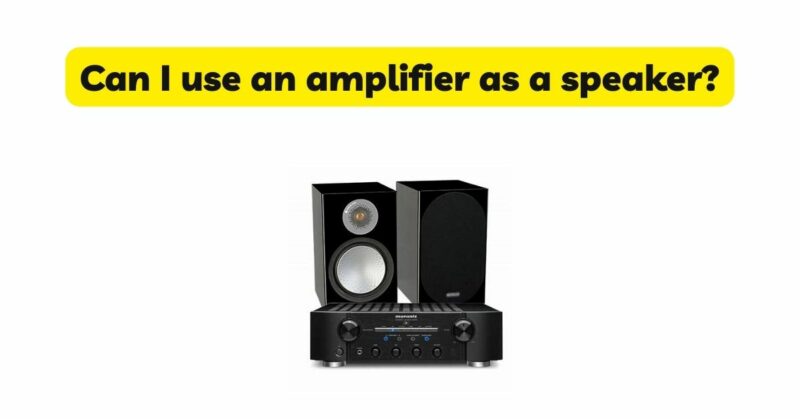In the realm of audio equipment, it’s common for individuals to wonder about the interchangeability of certain components. One such question that often arises is whether an amplifier can be used as a speaker or vice versa. While both amplifiers and speakers are integral to audio systems, they possess distinct functionalities and roles. In this article, we will delve into the details to clarify the differences between amplifiers and speakers, their individual functions, and whether it is possible to use an amplifier as a speaker or vice versa.
- Understanding Amplifiers:
Amplifiers, also known as amps, are electronic devices designed to increase the power of an audio signal. Their primary function is to take a low-power audio input and amplify it to a level suitable for driving speakers. Amplifiers come in various types, such as solid-state (transistor-based), tube (valve-based), and digital amplifiers. Regardless of the type, the main purpose of an amplifier is to boost the electrical signal without adding distortion or altering the original audio characteristics.
- The Function of Amplifiers:
Amplifiers play a crucial role in audio systems by providing the necessary power to drive speakers and reproduce sound accurately. They receive the audio signal from a source device, such as a music player or receiver, and increase its voltage and current. This amplified signal is then sent to the speakers, where it is converted into sound waves. Amplifiers are not designed to produce sound on their own; their purpose is to provide the power required to drive the speakers effectively.
- Understanding Speakers:
Speakers, on the other hand, are transducers that convert electrical signals into sound waves. They receive the amplified audio signal from the amplifier and use various components, such as cones, voice coils, and magnets, to vibrate and produce sound. Speakers are responsible for creating the audible output that we hear, translating the electrical energy into the mechanical vibrations that travel through the air as sound waves.
- The Function of Speakers:
The primary function of speakers is to reproduce sound faithfully, covering a wide range of frequencies. Different types of drivers within the speaker cabinet handle specific frequency ranges. Woofers are responsible for producing low-frequency sounds, such as bass and sub-bass. Mid-range drivers handle the middle frequency range, including vocals and instruments. Tweeters reproduce high-frequency sounds, such as cymbals and vocals. By working together, these drivers create a balanced and detailed sound reproduction.
- Distinctions and Compatibility:
It is crucial to understand that amplifiers and speakers are distinct components with specific functions. While an amplifier provides the power to drive the speakers, it cannot function as a speaker itself. Amplifiers lack the necessary components, such as cones and voice coils, to convert electrical signals into sound waves. Similarly, speakers are not designed to amplify audio signals; their purpose is to transform electrical energy into audible sound.
- Integration and Compatibility:
To achieve optimal audio performance, it is essential to consider the compatibility and integration of amplifiers and speakers within an audio system. Amplifiers and speakers are designed to work together in a cohesive manner. The power output of the amplifier should be matched with the power handling capabilities of the speakers to ensure efficient and distortion-free sound reproduction.
- Exploring Alternative Solutions:
While an amplifier cannot function as a speaker, there are alternative solutions available for those seeking amplification without separate speakers. One option is using powered speakers, also known as active speakers, which feature built-in amplifiers. Powered speakers combine the functions of amplification and sound reproduction in a single unit. They eliminate the need for a separate amplifier while providing convenience and simplicity in setup.
- Proper Equipment Selection:
When building an audio system, it is crucial to select the appropriate equipment for the desired outcome. Amplifiers should be chosen based on factors such as power output, impedance matching, and the specific requirements of the speakers being used. Likewise, speakers should be selected based on factors such as frequency response, sensitivity, and the intended use of the audio system. Proper equipment selection ensures compatibility and optimal performance.
Conclusion:
In conclusion, amplifiers and speakers serve distinct functions within audio systems. Amplifiers are responsible for amplifying the audio signal, providing the necessary power to drive the speakers. Speakers, on the other hand, convert electrical signals into sound waves, producing the audible output. While an amplifier cannot be used as a speaker or vice versa, their integration and compatibility are crucial for achieving optimal audio performance. By understanding the distinctions between amplifiers and speakers and selecting the appropriate equipment, individuals can create immersive and high-quality audio experiences that elevate their enjoyment of music, movies, and more.


